Architecture for Liturgy I
First liturgy week
16-20 January 2017
Monday lunch to Friday lunch
at the
Spiritual Life Center
Wichita, Kansas
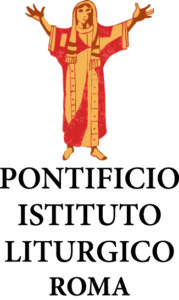 under the Patronage of the Pontifical Liturgy Institute, Rome
under the Patronage of the Pontifical Liturgy Institute, Rome
Download a flyer here and pass it on to your friends.
Liturgy Week 1 and 2
Celebrating liturgy involves bodily actions that narrate the mysteries celebrated. This bodily narration determines not only the functional aspects of church design, but even more importantly, the inner dimensions inherent in the ritual narrative are expressed outwardly through an artistic program well integrated into the architectural design and arrangement of churches.
Much attention is given to the design of functional and even transcendent buildings, but insufficient attention has been given to developing a prolonged ritual narration whose every element expresses in synthesis the whole mystery celebrated by rites, symbols and texts proper to each element, all of which is determinative of the design and arrangement of church buildings and their artistic programs.
The First Liturgy Week Architecture for Liturgy I begins with a pictorial journey through the ancient basilicas of Rome. Next, we consider several different arrangements for churches that arose during the discussions held at the Second Vatican Council (1962-1965). From these we shall consider the three primary human experiences and their respective places: personal illumination with light in the baptistery and font, ongoing maturation by the word in the hall and at the ambo, interpersonal communion through consummation at the dais and altar-ciborium. Both liturgy weeks include visits to selected churches with guided discussions on the liturgical principles realized, and not yet fully realized.
The Second Liturgy Week Architecture for Liturgy II begins with the distinction between allegory and sacramental symbol. Most of the week is spent considering the inner dynamics of liturgy according to four pairs: memorial-imitation, presentation-invocation, moral and eternal life, sharing in divine life. The goal of both liturgy weeks is the development of a “Ritual Model”, which consists of the liturgical principles guiding the ritual celebration of liturgy and the expression of its inner meaning through artistic programs integrated into the architectural design of a church.
Liturgy Week 1 and 2 are designed for:
⋅ Parish planning groups preparing to renovate or build a church or chapel,
⋅ Architects and artists seeking a commission for a renovated or new church,
⋅ Architects wishing to design a building that supports a fuller ritual narrative and integrates better its artistic program,
⋅ Artists seeking inspiration from dimensions inherent to the bodily celebration of rites for more integrated and fuller artistic programs,
⋅ Diocesan directors of offices of worship or commissions that govern the building or renovation of churches,
⋅ Pastors wishing a more universal, historical and thus catholic perspective for the design phase of building or renovating a church.
⋅ Liturgists wishing to develop the ritual narration of celebrating liturgy,
⋅ Ecumenical partners seeking our common tradition, sharing the recent liturgical renewal and considering our differentiated practices.
The presentations are clear, given in ordinary language for the informed person and are richly illustrated by pictorial journeys. This accessibility gives direct and immediate access to the inner dimensions of liturgical celebrations.
Learning Goals – Week 1
This method will help participants rise above the polarities in current discussions by giving them richer historical, more universal and deeper theological bases.
Participants will acquire an historical perspective from a pictorial tour of Roman basilicas and those of Jerusalem and Constantinople so that they may describe and assess the elements and arrangements of historical churches.
Participants will learn to identify and describe several different arrangements of churches that arose from discussions held at the time of the Second Vatican Council so that they may assess churches built in the last century.
Participants will learn to begin with the graced, human experience of celebrating liturgy from which flow the ritual narration, artistic program and architecture of a church.
Participants will develop a fuller vision with which they may help a community to develop its ritual celebration of liturgy.
Participants will learn to articulate how a fuller celebration of liturgy is reflected in a fuller development of the artistic program and architectural design of a church.
Participants will learn to describe how the dimensions inherent in the celebration of liturgy are expressed in the three dimensions of space in a church and the dimension of time throughout a day, season, year.
Participants will develop the tools to assess several different arrangements of churches and their contributions and weaknesses toward developing a more comprehensive ritual model.
Participants will be introduced to the ritual model which can help them articulate a full synthesis of action, art and architecture all providing a greater synthesis of the mysteries celebrated.
Monday afternoon, 16 January 2017
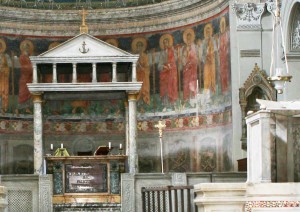 Roman Basilicas: A pictorial journey with surprising finds
Roman Basilicas: A pictorial journey with surprising finds
The basilicas of Rome survive from Christian antiquity and have been adapted in every era revealing much of the history of church architecture in their rich beauty. Their antiquity and continuity preserve elements that challenge contemporary church architecture. The first session from 1:30-3:00 will consider the Lateran basilica (the Cathedral church of Rome), St. Peter’s basilica and the basilica of St Paul Outside the Walls. The second session from 3:30-5:00 will feature the basilica of St Mary Major, St Mary in Trastevere and St Stephen in the Round (San Stephano Rotondo).
Further reading: “Gather them in”, in Come into the Light.
Monday evening
Presentation by a participant with group discussion. A participant is invited to present a particular parish to the group for discussion, particularly in regard to the challenge ancient churches pose to contemporary practice.
Tuesday morning, 17 January 2017
Vatican II discussion and documents
The documents of Vatican II allow for a church to be built in any architectural style with few qualifications such as nobility and permanence. The specifically architectural requirements of the council are few, specifically that the altar be free standing so that a person may walk around it. The conciliar documents mention a number of other ritual actions such as the full, conscious and active participation of the faithful, without spelling out the consequences for the architectural or artistic arrangement of a church. These references to ritual actions are better understood in light of the speeches made during the council as part of the deliberation on the proposals. Greater insight may be gained through an examination of the work accomplished before the council by the committees preparing for the council, and then after the council by the committee responsible for implementing the liturgical renewal mandated by the council.
I have examined:
- The initial survey that elicited topics for discussion;
- The minutes of the commission preparing the initial draft on Sacred Liturgy;
- The speeches given at the council;
- Tfter the council, the minutes of the working group responsible for developing the Ordo Missae, “Order of Mass”, and its successive versions;
- The minutes of the working group responsible for developing the General Instruction of the Roman Missal, and its successive versions.
My research into these documents reveals several liturgical arrangements promoted by different groups of conciliar participants. I shall present four arrangements from the conciliar discussion and an additional two arrangements that developed thereafter.
Further reading: “Tabe of good contents”, “Stand up for the Lord”, “A place for everyone”, in Come into the Light.
Tuesday afternoon
Tour of a local church
A representative of the parish community will give a tour of the church and describe its origins and the history of its development. The welcome begins at 2:00. At 2:30 we shall break for refreshments and conversation. From 3:00-4:30 Fr. Daniel will give a presentation and lead a discussion on some aspect of the ritual supported by the architectural design of the building and interpreted by the artistic program.
Ideally we would see this afternoon a church that exemplifies some arrangement following from a line of discussion at the Second Vatican Council.
Tuesday evening
Presentation by a participant with group discussion. A participant is invited to present a particular parish to the group for discussion, particularly in regard to the arrangements of a church following some discussion at the Second Vatican Council.
Wednesday morning, 18 January 2017
The thought of Prof. em. Crispino Valenziano: the basis of this week
Prof. em. Crispino Valenziano recently retired from his post as a professor of the Pontifical Institute of Liturgy, Sant’Anselmo, Rome. His unique synthesis is little known outside Italian academic circles, but is instrumental in elaborating and deepening an architecture for liturgy. Fr. Daniel was his student while conducting doctoral studies at Sant’Anselmo and so introduces the thought of Prof. Crispino Valenziano to the US in this first liturgy week. His thought given in this presentation structures the rest of this Liturgy Week. It centers on the three primary human experiences, each with its qualification; each corresponds to one part of the church which includes its proper monument:
1. Personal illumination is qualified by light in the baptistery whose monument is the baptismal font,
2. On-going maturation is qualified by the word proclaimed in the assembly hall from its monument the ambo and from the chair of the teacher,
3. Interpersonal communion is qualified by consummation around the altar-ciborium, the monument on the dais.
Further reading: “Introduction”, in Come into the Light.
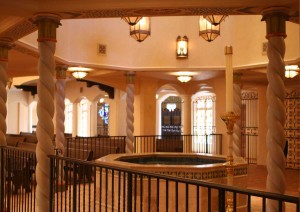 Baptistery and font: A pictorial journey of their history, ritual, theology, art and architecture
Baptistery and font: A pictorial journey of their history, ritual, theology, art and architecture
The primary experience of personal illumination is qualified by the natural light passing through the baptistery and in the assembly hall and dais as the faithful walk in the light toward sharing communion.
A pictorial tour will present baptisteries as places of illumination, both by natural light and personal experience, and baptismal fonts as the monuments of this personal illumination. The ritual, art and architecture all present different dimensions of personal illumination such as renunciation and dying, rising and walking, being born again in water and the Spirit, and adoption as children of God. The baptistery may also accommodate a place for the anointing after the water bath.
The design of the baptistery and its relationship to the main body of the church are important in developing the ritual model of church architecture, which parallels Christian initiation from baptism to communion.
Further reading: “Becoming light”, “Twoards the enduring city”, “A Time to be born”, “Water for ‘new plants’ “, “Church of the senses”, in Come into the Light.
Wednesday afternoon
Tour of a local church
A representative of the parish community will give a tour of the church and describe its origins and the history of its development. The welcome begins at 2:00. At 2:30 we shall break for refreshments and conversation. From 3:00-4:30 Fr. Daniel will give a presentation and lead a discussion on some aspect of the ritual supported by the architectural design of the building and interpreted by the artistic program.
Ideally we would see this afternoon a church that exemplifies all three primary places developed by Prof. Valenziano, especially a church with a well-developed baptistery.
Wednesday evening
Presentation by a participant with group discussion. A participant is invited to present a particular parish to the group for discussion, particularly in regard to the development of the three pre-eminent places of celebration, the baptistery with its font, the hall with its ambo and the dais with its altar-ciborium. In particular discussion may focus on the baptistery.
Thursday morning, 19 January 2017
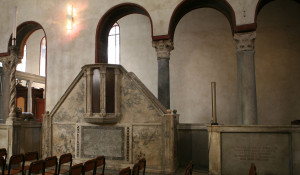
Ambo and hall: A pictorial journey of their history, ritual, theology, art and architecture
The primary human experience of on-going maturation develops throughout a lifetime of listening to the Word of God and responding in acclamations, song, psalms, homily, creed and prayer, culminating in the procession of the faithful, the body of Christ, toward Christ who comes in his body and blood as nourishment for our sharing communion. The place of this on-going maturation is the assembly hall with its monument the ambo from which the scripture is proclaimed according to its own proper ritual pattern. Associated with the ambo are the chairs for the assembly, including the chair of the teacher and presider in the liturgical assembly.
The distinction between an ambo, lectern and pulpit will begin the presentation which continues with a pictorial journey of the ambo in history, ritual, theology, art and architecture. The ambo remains one of the least developed elements of contemporary church architecture, even though the renewed liturgy of the Word and revised lectionary are some of the richest developments following the Second Vatican Council. Recovery of the ambo with its proper symbolic structure is key in the development of church architecture more adequate to the renewed liturgy of the Word.
Further reading: “Mix and match”, Assembled as one”, “Make a gift of your ministry”, Discoveries at an empty tomb”, “Raise up the word”, in Come into the Light.
Thursday afternoon
Tour of a local church
A representative of the parish community will give a tour of the church and describe its origins and the history of its development. The welcome begins at 2:00. At 2:30 we shall break for refreshments and conversation. From 3:00-4:30 Fr. Daniel will give a presentation and lead discusion on some aspect of the ritual supported by the architectural design of the building and interpreted by the artistic program.
Ideally we would see a church that exemplifies all three preeminent qualities developed by Prof. Valenziano, especially a church with a well-developed ambo in the midst of the assembly, or more probably a church that could be arranged to include an ambo in the assembly hall.
Thursday evening
Presentation by a participant with group discussion. A participant is invited to present a particular parish to the group for discussion, particularly in regard to the development of the three pre-eminent places of celebration, the baptistery with its font, the hall with its ambo and the dais with its altar-ciborium. In particular discussion may focus on the assembly hall and ambo.
Friday morning, 20 January 2017
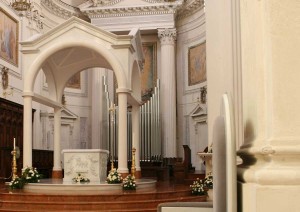 The Dais with its altar-ciborium: A pictorial journey of their history, ritual, theology, art and architecture
The Dais with its altar-ciborium: A pictorial journey of their history, ritual, theology, art and architecture
The primary human experience of inter-personal communion is qualified by consummation, that is by consuming a meal and of being consumed in nuptial union. This occurs during the wedding feast of the lamb celebrated at the altar-ciborium, which stands as its monument located on the dais.
A pictorial tour of the design and arrangement of altars in early Roman basilicas and in Constantinople and their later development will shed light on the artistic narrative around the altar with particular focus on development of the ciborium or baldachin standing over the altar and of the altar back or reredos. This historical survey helps to situate the current discussion about the placement and design of the altar.
The role of the Holy Spirit in all liturgical prayer is projected in the architecture of the ciborium or baldachin. Reclaiming the altar-ciborium combination from Roman examples counters the modern tendency of placing the altar in the geographic center, under the dome or under the crossing of a cruciform church. Re-establishing the altar-ciborium combination is helpful in developing distinct places for ritual activity proper to the altar, the ambo, the presidential chair, the baptismal font, and it frees the central space for a vertical axis, the axis mundi, “pole of the world”, with its proper ritual activity.
Further reading: “To and from the living waters”, in Come Into the Light.
Ritual Model synthesis
Over the course of the week we shall discuss the basis of the ritual model, the three primary human experiences, their qualifications and their places and monuments. These correspond to the process of Christian initiation consisting of being baptized in the water bath and anointed and then being brought to share in communion in the Lord’s Supper. After one is so initiated, the process repeats with the liturgy of the word leading to sharing communion. This ritual pattern also structures the places of celebration from baptistery through the hall to the dais, from light through word to consummation, from the font pausing at the ambo and chair then continuing to the altar-ciborium.
As a model, the ritual model is more comprehensive than the other more limited arrangements based on the pastoral desires to face the people, to stand around a central altar, to be nourished more fully at the table of the Word and then at the banquet table. The two-part structure of liturgy suggests a two-part arrangement of the space. These and other arrangements are integrated into a more prolonged ritual narrative in the ritual model whose three primacies each provide a synthesis of the whole mystery celebrated in rites and symbols proper to each primacy.
The three churches we shall visit provide examples of different arrangements and places where we may discuss the strengths and limitations of each as measured against the ritual model developed in this first liturgy week from the thought of Prof. em. Crispino Valenziano.
Further reading: “Becoming Christians”, in Come into the Light.
Conclusion
The last presentation ends at 11:45 and is followed by an awards ceremony in which participants receive a certificate of participation. Participants who miss a half-day session or more receive a certificate that states humana pro facultate, “according to human possibilities”. Lunch follows the awards ceremony.
Monday 16 January 2017
Morning: arrival
Note: Participation in religious services is voluntary and not expected.
11:45-12:45
Lunch Cafeteria
Afternoon – SL Center
12:55-1:10
Welcome
Cana Room
1:10-2:25
Roman Basilicas
Cana Room
2:25-2:55
Refreshments
Cana Room
2:55-4:10
Roman Basilicas
Cana Room
4:20-5:05
Mass Chapel
5:20-6:20
Supper Cafeteria
6:25-6:45
Evening Prayer Chapel
7:00-8:00
Lecture by Fr. Daniel
& guided discussion at
Church of the resurrection
4910 N. Woodlawn
Wichita, KS 67220
316.744.2776
church@resurrectionwichita.com
Transport to hotel, if needed.
Tuesday 17 January 2017
Breakfast on your own
at the hotel.
8:00
Transport from hotel, if needed.
Morning: SL Center
8:15-8:40
Morning Prayer
Chapel
8:40-9:40
Lecture by Fr. Daniel:
Vatican II arrangements
Cana Room
9:40-10:10
Refreshments
Cana Room
10:10-11:40
Lecture by Fr. Daniel
Vatican II arrangements
Cana Room
11:45-12:45
Lunch Cafeteria
12:50-1:00
Midday Prayer Chapel
Afternoon: Church visit
1:10
Depart for Blessed Sacrament Parish Church
124 N Roosevelt
Wichita, KS 67208
316-682-4557
E-mail Rachael Hittner
1:40-2:00
Personal time
in the church
2:00-3:00
Lecture by Fr. Daniel
& Guided discussion
3:00-3:20
Refreshments
& informal discussion
3:30-3:45
Tour of Church
by pastor or staff
3:45
Return to SLC
4:20-5:05
Mass Chapel
5:20-6:20
Supper Cafeteria
6:25-6:45
Evening Prayer Chapel
7:00-8:00
Participant presentation
Cana Room
Transport to hotel, if needed.
Wednesday 18 January 2017
Breakfast on your own
at the hotel.
8:00
Transport from hotel, if needed.
Morning: SL Center
8:15-8:40
Morning Prayer
Chapel
8:40-9:40
Lecture by Fr. Daniel
Thought of Valenziano
Cena Room
9:40-10:00
Refreshments
Cena Room
10:10-11:40
Lecture by Fr. Daniel
Baptistery & font
Cana Room
11:45-12:45
Lunch Cafeteria
12:50-1:00
Midday Prayer Chapel
Afternoon: Church visit
1:10
Depart for Christ the King Parish Church
4411 W Maple
Wichita, KS 67209
Phone: 316.943.4353
parish@ctkwichita.org
1:40-2:00
Personal time
in the church
2:00-3:00
Lecture by Fr Daniel
& Guided discussion
3:00-3:20
Refreshments
& informal discussion
3:30-3:45
Tour of Church
by pastor or staff
3:45
Return to SLC
4:20-5:05
Mass Chapel
5:20-6:20
Supper Cafeteria
6:25-6:45
Evening Prayer Chapel
7:00-8:00
Participant presentation
Cana Room
Transport to hotel, if needed.
Thursday 19 January 2017
Breakfast on your own
at the hotel.
8:00
Transport from hotel, if needed.
Morning: SL Center
8:15-8:40
Morning Prayer Chapel
8:40-9:40
Lecture by Fr. Daniel:
The Ambo
Cana Room
9:40-10:10
Refreshments
Cana Room
10:10-11:40
Lecture by Fr. Daniel
The Ambo
Cana Room
11:45-12:45
Lunch Cafeteria
12:50-1:00
Midday prayer Chapel
Afternoon: Church visit
1:10
Depart for St. Vincent de Paul
parish Church
123 N. Andover
Andover, KS 67002
316.733.1423
office@svdpks.org
1:40-2:00
Personal time
in the Church
2:00-3:00
Lecture by Fr. Daniel
& Guided discussion
3:00-3:20
Refreshments
& informal discussion
3:30-3:45
Tour of Church
by pastor or staff
3:45
Return to SLC
4:20-5:05
Mass Chapel
5:20-6:20
Supper Cafeteria
6:25-6:45
Evening Prayer Chapel
7:00-8:00
Participant presentation
Cena Room
Transport to hotel, if needed.
Friday 20 January 2017
Breakfast on your own
at the hotel.
8:00
Transport from hotel, if needed.
Morning: SL Center
8:15-8:40
Morning Prayer Chapel
8:40-9:40
Lecture by Fr Daniel
Altar-ciborium
Cana Room
9:40-10:05
Refreshments
Cana Room
10:05-11:35
Lecture by Fr. Daniel:
Ritual model
Cana Room
11:35-11:45
Certificates
11:50-12:45
lunch Cafeteria
Lunch
Departure
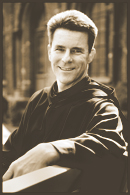 Fr Daniel McCarthy, OSB, SLD
Fr Daniel McCarthy, OSB, SLD
Fr Daniel is a monk of St Benedict’s Abbey, Atchison, Kansas. In 2008 he earned a Doctorate in Sacred Liturgy (SLD) studying church architecture at the Pontifical Institute of Liturgy at Sant’Anselmo, Rome. His doctoral thesis traces the historical development of the presidential chair (the chair the priest sits in for Mass). Because the chair is the weaker element compared to the altar and ambo (or lectern), his research required developing an understanding of the interrelationships of all these elements in the overall design of a church. While pursuing these studies, Fr Daniel studied with Prof em. Crispino Valenziano.
Fr Daniel is an instructor at the Pontifical Institute of Liturgy, at Sant’Anselmo, Rome where he also participates in the Master’s degree program on Architecture and Arts for Liturgy. He is a guest professor at the Catholic University Leuven, in Belgium, where he serves on the editorial board of Questions Liturgiques / Studies in Liturgy. He is co-founder and instructor of liturgy and the Latin language at the Liturgy Institute London, at Ealing Abbey. Fr Daniel has published with Fr James Leachman a volume on ritual, art and architecture called Come Into the Light. Fr Daniel is currently amplifying his doctoral research and preparing it for publication in English. He is also preparing the presentations given in these two liturgy weeks Architecture for Liturgy 1 and 2 for publication.
Fr Daniel also serves as an advisor to Vox clara, a working committee of the Vatican Congregation for Divine Worship and the Discipline of the Sacraments. He publishes with Fr Reginald Foster a series on teaching the Latin language. The first volume is Ossa Latinitatis Sola: The Mere Bones of Latin.
Fr Daniel holds the following degrees:
S.L.D, Doctorate in Sacred Liturgy, Pontifical Liturgy Institute, Sant’Anselmo 2008,
S.L.L, License in Sacred Liturgy, Pontifical Liturgy Institute, Sant’Anselmo,
M.A. specializing in liturgy from the Notre Dame summer program, 1999,
M.Div. from St John’s Seminary, Collegeville, Minnesota where he studied under the church designer Frank Kasmarcik,
B.A. from Benedictine College, Atchison Kansas, 1985.
REGISTRATION:
Online registration is made by filling out a form provided by the Catholic Diocese of Wichita now available at this link.
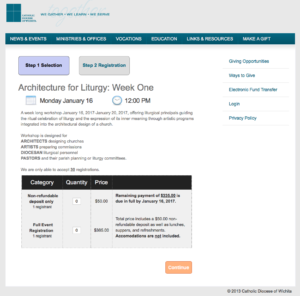
OR You may register in advance by phone (with a credit card) by calling: Sister John Patrick in the Office of Worship at: 316-440-1701.
OR You may register by sending in your information with a check for the full amount, or a $50.00 non-refundable deposit, made out to: Catholic Diocese of Wichita, with a memo of “liturgy week” and post it to:
Catholic Diocese of Wichita
Attn: Worship Office – “Liturgy Week”
424 N Broadway
Wichita KS 67202
COST: $385 per person; this includes the event fee, lunch, supper and refreshments. Because this experience is of a whole, it is preferable that participants attend all the presentations. Thus, no discount is given for those who cannot attend the entire experience.
Payment in full may be made upon registration
OR a non-refundable $50.00 deposit is due at registration to guarantee a place for
the Liturgy Week since we are only able to accept 30 participants.
Payment in full is due by January 16, 2017.
HOTEL: if you need accommodations, a block of rooms has been reserved at:
Northrock Suites
7856 E 36th St N
Wichita, KS 67226
316-634-2303 / 1-800-881-0067
info@northsuiteshotel.com
A map showing the two-three mile journey from the Northrock Suites to the Spiritual Life Center is available here.
Please make arrangements directly with the hotel and specify that you’re registering as part of the Architecture Week group. The group rate is $79.99 per night for either a King bed or 2 double beds. A hot breakfast buffet is included.
The DEADLINE to reserve is room is December 13, 2016. After that date, the rate will remain the same, but availability is NOT guaranteed.
The hotel is an easy drive of only 2.7 miles from the Spiritual Life Center. A map showing the journey is available here. Transportation to and from the hotel may be arranged, if desired.
AIRPORT: The local airport is known as the Wichita Dwight D. Eisenhower National Airport. It is located a 21-minute drive from the Spiritual Life Center. When you register, please indicate the need for transportation from and to the airport along with flight information.
REGISTRATION:
Online registration is made by filling out a form provided by the Catholic Diocese of Wichita now available at this link.

OR You may register in advance by phone (with a credit card) by calling: Sister John Patrick in the Office of Worship at: 316-440-1701.
OR You may register by sending in your information with a check for the full amount, or a $50.00 non-refundable deposit, made out to: Catholic Diocese of Wichita, with a memo of “liturgy week” and post it to:
Catholic Diocese of Wichita
Attn: Worship Office – “Liturgy Week”
424 N Broadway
Wichita KS 67202
COST: $385 per person; this includes the event fee, lunch, supper and refreshments. Because this experience is of a whole, it is preferable that participants attend all the presentations. Thus, no discount is given for those who cannot attend the entire experience.
Payment in full may be made upon registration
OR a non-refundable $50.00 deposit is due at registration to guarantee a place for
the Liturgy Week since we are only able to accept 30 participants.
Payment in full is due by January 16, 2017.
HOTEL: if you need accommodations, a block of rooms has been reserved at:
Northrock Suites
7856 E 36th St N
Wichita, KS 67226
316-634-2303 / 1-800-881-0067
info@northsuiteshotel.com
A map showing the two-three mile journey from the Northrock Suites to the Spiritual Life Center is available here.
Please make arrangements directly with the hotel and specify that you’re registering as part of the Architecture Week group. The group rate is $79.99 per night for either a King bed or 2 double beds. A hot breakfast buffet is included.
The DEADLINE to reserve is room is December 13, 2016. After that date, the rate will remain the same, but availability is NOT guaranteed.
The hotel is an easy drive of only 2.7 miles from the Spiritual Life Center. A map showing the journey is available here. Transportation to and from the hotel may be arranged, if desired.
AIRPORT: The local airport is known as the Wichita Dwight D. Eisenhower National Airport. It is located a 21-minute drive from the Spiritual Life Center. When you register, please indicate the need for transportation from and to the airport along with flight information.
This experience is currently not offered for credit.
I would like to develop this program as a master’s level course.
Credit seeking students would be expected to read a fuller bibliography.
Criteria for evaluation would include a written essay and / or an oral exam.
Pontifical Liturgy Institute, Rome
 The Liturgy Study Week is organised with the patronage of
The Liturgy Study Week is organised with the patronage of
the Pontifical Liturgy Institute, Sant’Anselmo, Rome,
where Fr. Daniel serves on the faculty of Liturgy.
This liturgy week is offered in conjunction with
the Master’s degree in Arts and Architecture for Liturgy
also offered by the Pontifical Liturgy Institute.
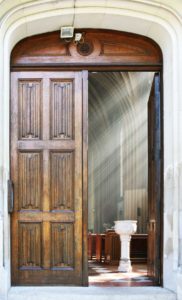 The following volume is recommended to accompany the presentations:
The following volume is recommended to accompany the presentations:
Church interiors for the celebration of liturgy
by
Daniel P. McCarthy osb
James G. Leachman osb
published by Canterbury Press, Norwich 2016.
Available via Amazon.com.
A secondary resource has several images of the ambo of Santa Sabina, Rome, with explanations:
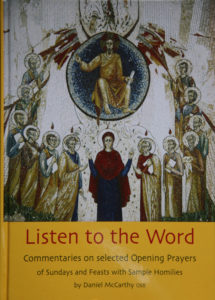 McCarthy, D.P. – J.G. Leachman, Listen to the Word: Commentaries on Selected Opening Prayers of Sundays and Feasts with Sample Homilies (DREI, Varia), The Tablet Trust, London 2009.
McCarthy, D.P. – J.G. Leachman, Listen to the Word: Commentaries on Selected Opening Prayers of Sundays and Feasts with Sample Homilies (DREI, Varia), The Tablet Trust, London 2009.
Available through the gift shop of St. Benedict’s Abbey, Atchison, in person or online here.
Note, the publisher has not made this volume available on amazon.com, where it is sold by resellers at vast mark-up.
A fuller bibliography intended to accompany the Liturgy Week is available on the bibliography page of this web-site.
The schedule for Thursday and Friday are located under a separate tab called simply “Tab” for technical reasons.